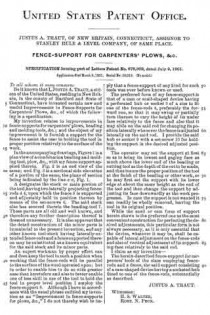
| PLEASE NOTE: The images presented on this page are of low resolution and, as a result, will not print out very well. If you wish to have higher resolution files then you may purchase them for only $2.95 per patent by using the "Buy Now" button below. All purchases are via PayPal. These files have all been cleaned up and digitally enhanced and are therefore suitable for printing, publication or framing. Each zip package contains all the images below (some packages may contain more), and purchased files can be downloaded immediately. |
UNITED STATES PATENT OFFICE.
_________________
JUSTUS A. TRAUT, OF NEW BRITAIN, CONNECTICUT, ASSIGNOR TO
STANLEY RULE & LEVEL COMPANY, OF SAME PLACE.
FENCE-SUPPORT FOR CARPENTERS’ PLOWS, &c.
_________________
SPECIFICATION forming part of Letters Patent No. 678,309, dated July 9, 1901.
Application filed Mar 6, 1901. Serial No. 50,015. (No model.)
_________________
To all whom it may concern:
Be it known that I, JUSTUS A. TRAUT, a citizen of the United States, residing in New Britain, in the county of Hartford and State of Connecticut, have invented certain new and useful Improvements in Fence-Supports for Carpenters’ Plows, &c., of which the following is a specification.
My invention relates to improvements in fence-supports for carpenters’ plows, beading and molding tools, etc.; and the object of my improvement is to furnish a support for the fence to assist the user in holding the tool in proper position relatively to the surface of the work.
In the accompanying drawings, Figure 1 is a plan view of a combination beading and molding tool, plow, &c., with my fence-support applied thereto. Fig. 2 is an end view of the same; and Fig. 3 is a sectional side elevation of a portion of the same, the plane of section being indicated by the line x x, Fig. 1.
A designates the stock or main portion of the tool, having two laterally projecting fence-rods 4 4, upon which the fence 5 is supported and adjustably held in position thereon by means of the set-screws 6. The said stock also has secured therein the beading-tool 7. These parts are all old and well known, and therefore any further description thereof is deemed unnecessary. It is also apparent that the detail construction of the minor parts is immaterial to the present invention, and any other known tool-stock having laterally-extended fence-rods and a fence supported thereon may be substituted as a known equivalent for the said stock and its minor parts.
An expert workman by proper effort can and does keep the tool in such a position when working that the fence-rods will be parallel to the surface of the wood operated upon; but in order to enable him to do so with greater ease than heretofore and also to better enable one of less skill in use of the tool to hold the tool in proper level position I employ the fence-support 8. Although I have in accordance with the usual phrase entitled my invention as an “Improvement in fence-supports for plows, &c.,” I do not thereby wish to imply that a fence-support of any kind for such tools was ever before known or used.
The preferred form of my fence-support is that of a cam or snail-shaped device having a perforated hub or socket 9 of a size to fit one of the fence-rods 4, preferably the forward one, so that it may swing or partially turn thereon to vary the height of its under face relatively to the fence and also that it may slide on the said rod for changing its position laterally whenever the fence is adjusted laterally on the said rod. I provide the said hub or socket 9 with a set-screw 10 for holding the support in the desired adjusted position.
The operator may set the support at first so as to bring its lowest and gaging face as much above the lower end of the beading or cutting tool as the depth of the cut to be made, and thus insure the proper position of the tool at the nnish of the beading or other work, or he may first set the support with its lower edge at about the same height as the end of the tool and then change the support by adjusting its face downwardly as the work progresses. In case the support is not wanted it can readily be wholly removed, leaving the tool in its original position.
While the snail or cam form of support herein shown is the preferred one as the most convenient construction for perfecting the desired adjustments, this particular form is not always necessary, as it is only essential that the device, whatever it may be, shall be capable of lateral adjustment on the fence-rods and also of vertical adjustment of its supporting-face relatively to the said rod.
I claim as my invention —
The herein-described fence-support for carpenters’ tools of the class employing fence-rods and a fence, the said support consisting of a cam-shaped device having a socketed hub fitted to one of the fence-rods, substantially as described.
JUSTUS A. TRAUT.
Witnesses:
H. S. WALTER,
ROBT. N. PECK.


